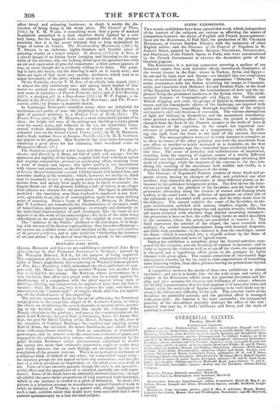130NNAR'S JOHN KNOX.
MESSRS. HODGSON and GRAVES are exhibiting a picture of John Knox Administering the first Protestant Sacrament in Scotland ; painted by Mr. WILLIAM BONNAR, R.S.A., for the purpose of being engraved. The commission given to the painter doubtless originated in the popu- larity of Doo's magnificent line-engraving of WILKIE'S famous picture of John Knox Preaching, which stimulated the rival publishers to com- pete with Mr. Moos : but neither another W/LKIE nor another Doo was to be had for the asking. Mr. BONNAR, whose performance is a very creditable first effort on a grand scale, has to contend against the disadvantage of a comparison with the great master, whose style of drawing, painting, and composition, he appears to have done his best to emulate ; while Mr. Rym.J., who is to engrave the plate, will have his execution in the "mixed style" of stipple, chalk, and line, put against one of the chefs-d'ceuvre of line-engraving. The picture represents Knox in the act of addressing the Protestant congregation in the crypt-like chapel of St. Andrew's Castle, to whom the elders are distributing the sacred elements at several tables, accord- ing to the Scottish usage : behind him stands his colleague, John Rough, chaplain to the garrison; and among the communicants are the stern Lord Ruthven, the good Earl of Glencairn, fierce Sir James Bal- four, the poet Sir David Lindsay of the Mount, Norman Leslie, (one of the assassins of Cardinal Beatoun,) the sensitive and aspiring young Earl of Arran, the venerable Sir James Sandilands, and others of less note, with some female relatives. Such an assemblage of remarkable personages, clad in armour or in the sumptuous costumes of peace, and engaged in the celebration of a solemn ordinance administered by the great Scottish Reformer under circumstances calculated to render the sacred rite more than ordinarily impressive, ought to excite deep and lively interest ; but no such feelings are awakened by the con- templation of the present canvass. There is no pervading sentiment of a religious kind, or indeed of any other: the composition wants unity ; the separate groups do not appear to have any connexion ; and the pic- ture as a whole produces no impression on the mind even as a work of art. Parts of it are cleverly painted, though the style is not agreeable : aerial effect and the appearance of a crowded assembly are well repre- sented. Some of the heads have an admirably distinct character; though all exhibit the same facial proportions of long noses and high foreheads, which in one instance is carried to a pitch of deformity. In short, this picture is a laborious attempt to manufacture a grand historical work to order, in imitation of WiLinz, by a painter who, though inadequate to such a task, exhibits talent that might have been successful had it been exerted spontaneously on a less elevated subject.


























 Previous page
Previous page